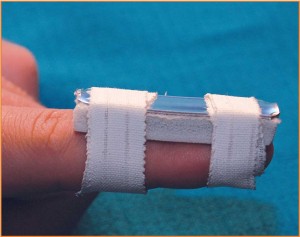What is Mallet Finger?
A mallet finger is a deformity of the finger caused when the tendon that straightens your finger (extensor tendon) is damaged. When a ball or other object strikes the tip of the finger or thumb and forcibly bends it, the force tears the tendon that straightens the finger (see Figure 1a and 1b). The force of the blow may even pull away a piece of bone along with the tendon (see Figure 2). The finger or thumb is not able to straighten. This condition is also sometimes referred to as baseball finger.


Figure 1a and 1b: The pictures above show an example of mallet finger with drooping of the tip


Figures 2a and 2b: X-rays of Mallet Fingers, note drooped posture of finger tip. Figure 2a shows fracture fragment where the extensor tendon is attached. Figure 2b shows intact bone, injury is to tendon only.
Symptoms
The key finding with a mallet finger is that the fingertip droops; that is, it cannot straighten on its own power. The finger may be painful, swollen and bruised, especially if there is an associated fracture, but often the only finding is the inability to straighten the tip. Occasionally, blood collects beneath the nail. The nail can even become detached from beneath the skin fold at the base of the nail.
Diagnosis
The diagnosis is evident by the appearance of the finger. X-rays are often ordered to see if you have pulled off a piece of bone and to make sure the joint is aligned.
Nonsurgical Treatment
The majority of mallet finger injuries can be treated without surgery. Ice should be applied immediately, and the hand should be elevated (fingers toward the ceiling.) Medical attention should be sought within a week after injury. It is especially important to seek immediate attention if there is blood beneath the nail or if the nail is detached. This may be a sign of a nail bed laceration or an open (compound) fracture.
There are many different types of splints/casts for mallet fingers. The goal is to keep the fingertip straight until the tendon heals. Most of the time, a splint will be worn full time for eight weeks (see Figure 3). Over the next three to four weeks, most patients gradually begin to wear the splint less frequently. The finger usually regains acceptable function and appearance with this treatment. Nevertheless, it is not unusual to lack some extension at the conclusion of treatment. Your surgeon will instruct you about how to wear the splint and will also show you exercises to maintain motion in the middle joint (proximal interphalangeal joint) so your finger does not become stiff. Once your surgeon feels your mallet finger has healed, he/she will show you exercises to regain motion in the fingertip itself.

Figure 3 : Splint supporting tip in extension
In children, mallet finger injuries may involve the cartilage that controls bone growth. The doctor must carefully evaluate and treat this injury in children, so that the finger does not become stunted or deformed.
Surgical Treatment
Surgical repair may be considered when mallet finger injuries have large bone fragments or joint mal-alignment. In these cases, pins, wires or even small screws are used to secure the bone fragment and realign the joint. Surgery may also be considered if non-surgical treatment is not successful in restoring adequate finger extension. Surgical treatment of the damaged tendon can include tightening the stretched tendon tissue, using tendon grafts or even fusing the joint straight. Your surgeon will advise you on the best technique in your situation.
Download a PDF on Mallet Finger





